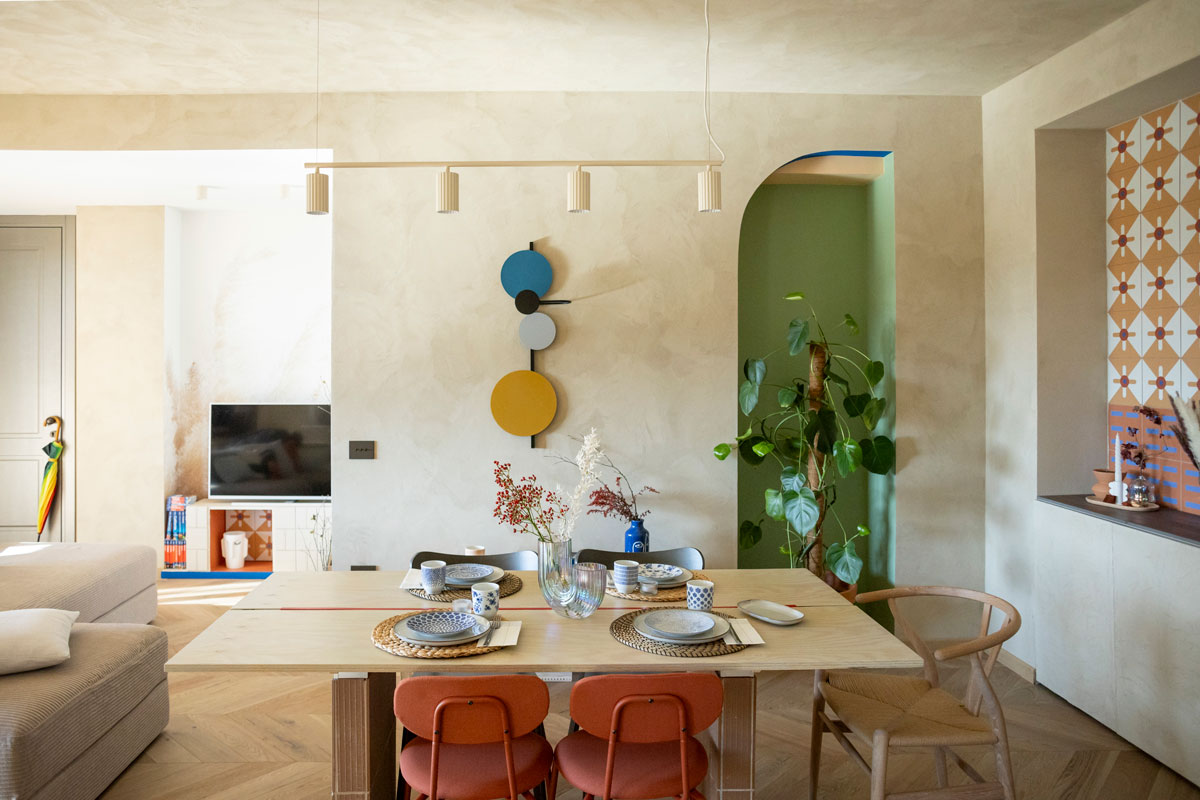Christian Andersen is Head of Design for Republic of Fritz Hansen, iconic Danish design brand.
Since he joined the company, exciting new things have happened. One of the most recent being the collaboration with Nendo, who designed an all-wooden chair for the Danish brand. The chair was launched at the last Salone del Mobile 2018 and it was exactly during the last Milan Design Week that I met Christian. Do you remember that I interviewed Paola Navone and Laura Bethan Wood? Christian was the third and last designer that I had the pleasure to speak with.
Some people say that designers need to be a little extravagant. Well, Christian looks nothing like extravagant: he is calm, confident and an elegant black-wearer. But his ideas are forward-thinking, and in this 15 minutes interview we talked about trends and news in the design world. And also about his personal life and why he considers himself as a mix of a consultant and an actor!
I was very inspired by this man after talking to him, and I’m sure you will be as well.
[ ITALIAN VERSION BELOW ]
– Christian Andersen Interview –

M | We are approaching this Design Week looking for new materials, innovations, etc. Have you already spotted something to be noted in this sense to recommend to us?
C | I think there is a huge sustainability wave, this is a big trend. We know for example that companies don’t want to buy products with chrome on them, because many people have allergies. It’s not just a trend, it’s a natural wave of conscience that will set new standards. Also there’s a development in materials that are maybe not cradle to grave but at least is able to be disassembled in a life circle, or reused. On the other hand the “use and throw” is disappearing. People rather wait to have a better quality product. We want to buy quality and the younger generations are much more informed than my generation was. They have another generation standard, they want to focus on quality and they want to understand the story of a product.

M | The readers of ITALIANBARK are mainly Millennials and young professionals. What were you doing in your late 20s/30s?
C | When I was 27 years old I was applying to design school. I spent the first time of my life as a young men wanting to be an engineer, so I started studying mechanical engineering and then I realised I was more interested in how the product looked. So I took a leave from the studies. I spent some time travelling and some time working and I realised that I was probably more interested in something that has to do with the shape, function and aesthetic of a product, rather than the actual inner working. And I realised within a few years that design was the way to go. So I applied for design school when I was 27 and I came in. I also became a father, I actually created my future work life and my future family both while I was between 27 and 29. And straight after design school I already had two kids, I started working in a big design studio in Denmark and spent 10 years there. And then when I was in my late 40s I switched and became head of design in a big company, trying to promote and build that design brand. And I did this until I was 50. And then I switched again to Fritz Hansen, so maybe I’ll stay here until I’m 60, it’s always been 10 years waves for me. So this is only my third job, because they have all been very long.

M | What’s your approach with the brands you work for?
C | I have never worked as an individual designer, I never had my own studio, I’ve always worked at studios. Designers hate it when you say it but it’s nevertheless true: designers are consultants. They are selling themselves to companies who want to use their skills and creativity to become more beautiful, more unique in market, more innovative […]. And that’s the key: designers need to be equal consultants and equal partners with the companies they work for. It’s like being an actor: […] you need to seduce your clients in order to have more emotional relationship with them. You need to create an illusion, that’s tough but also extremely giving when you succeed.

–
Would you like to discover more news about Fritz Hansen and Christian Andresen?
Read the full interview in our NT e-book!
[ ITALIAN VERSION ]
Christian Andersen è “Head of Design” per Republic of Fritz Hansen, iconico marchio di design danese. Da quando è entrato a far parte dell’azienda, sono accadute molte novità entusiasmanti. Una delle più recenti per esempio è la collaborazione con Nendo, che ha progettato una sedia interamente in legno per il marchio danese. La sedia ha debuttato all’ultimo Salone del Mobile 2018 ed è stato proprio durante la settimana del design che io ho incontrato Christian. Vi ricordate che ho intervistato Paola Navone e Laura Bethan Wood? Christian è stato il terzo e ultimo designer con cui ho avuto il piacere di parlare.
Alcuni dicono che i designer devono essere un po’ stravaganti. Direi che Christian non ha per niente un aspetto stravagante: è calmo, sicuro di sé e veste elegantemente in nero. Ma le sue idee sono lungimiranti e in questa intervista di 15 minuti abbiamo parlato di tendenze e novità nel mondo del design. E anche della sua vita personale e del perché si considera un mix fra consulente e attore!
E’ stato davvero di ispirazione parlare con quest’uomo, e sono sicura che lo sarà anche per voi.
– Intervista con Christian Andresen –
M | Stiamo approcciando questa settimana del design alla ricerca di nuovi materiali, innovazioni, ecc. Hai già notato qualcosa da consigliarci?
C | Penso che ci sia un’enorme tendenza verso la sostenibilità. Sappiamo ad esempio che le aziende non vogliono acquistare prodotti che contengono cromo, perché molte persone sono allergiche. Non è solo una tendenza, è una naturale ondata di coscienza che stabilirà nuovi standard di design e produzione. C’è anche uno sviluppo di materiali che magari non saranno completamente riciclabili, ma almeno possono essere riutilizzati. D’altra parte l’abitudine di comprare oggetti “usa e getta” sta scomparendo. Le persone piuttosto aspettano per avere un prodotto di qualità migliore. Oggi vogliamo comprare prodotti di qualità e le giovani generazioni sono molto più informate della mia generazione. Hanno un altro standard, vogliono concentrarsi sulla qualità e vogliono capire la storia dei prodotti.

M | I lettori di ITALIANBARK sono principalmente Millennial e giovani professionisti. Cosa stavi facendo quando avevi 20 e 30 anni?
C | Quando avevo 27 anni stavo facendo domanda per la scuola di design. Ho trascorso la prima parte nella mia vita da giovane volendo diventare un ingegnere, quindi ho iniziato a studiare ingegneria meccanica. E poi mi sono reso conto che ero più interessato all’estetica dei prodotti. Così ho preso una pausa dagli studi. Ho trascorso un po’ di tempo viaggiando e un po’ di tempo lavorando e ho capito che ero più interessato alla forma, la funzione e l’estetica di un prodotto, piuttosto che il suo reale meccanismo di funzionamento. E ho capito nel giro di pochi anni che il design era la strada da percorrere. Così ho fatto domanda per la scuola di design quando avevo 27 anni e sono entrato. Sono diventato anche padre, in realtà ho creato la mia futura vita lavorativa e la mia futura famiglia mentre ero tra i 27 e i 29 anni. E subito dopo la scuola di design avevo già due bambini, ho iniziato a lavorare in un grande studio di design in Danimarca e lì ho trascorso 10 anni. E poi, quando avevo circa 40 anni, sono diventato capo del design in una grande azienda, cercando di promuovere e costruire quel marchio. E l’ho fatto fino all’età di 50 anni. E poi sono passato a Fritz Hansen, quindi forse resterò qui fino a quando avrò 60 anni, sono sempre state onde di 10 anni per me. Quindi questo è solo il mio terzo lavoro, perché sono stati tutti molto lunghi.
M | Qual è il tuo approccio con i marchi per cui lavori?
C | Non ho mai lavorato come designer indipendente, non ho mai avuto il mio studio, ho sempre lavorato negli studi. I designer lo odiano quando lo dici ma è comunque vero: i designer sono dei consulenti. Si stanno vendendo a società che vogliono usare le loro capacità e creatività per diventare più belle, più uniche nel mercato, più innovative […]. E questa è la chiave: i progettisti devono essere allo stesso tempo consulenti e partner con le aziende per cui lavorano. È come essere un attore: […] devi sedurre i tuoi clienti per avere un rapporto più emotivo con loro. Devi creare un’illusione, è dura ma anche estremamente gratificante quando ci riesci.

–
Leggi l’intervista completa nel nostro eBook N/T qui
–
All images courtesy Republic of Fritz Hansen






